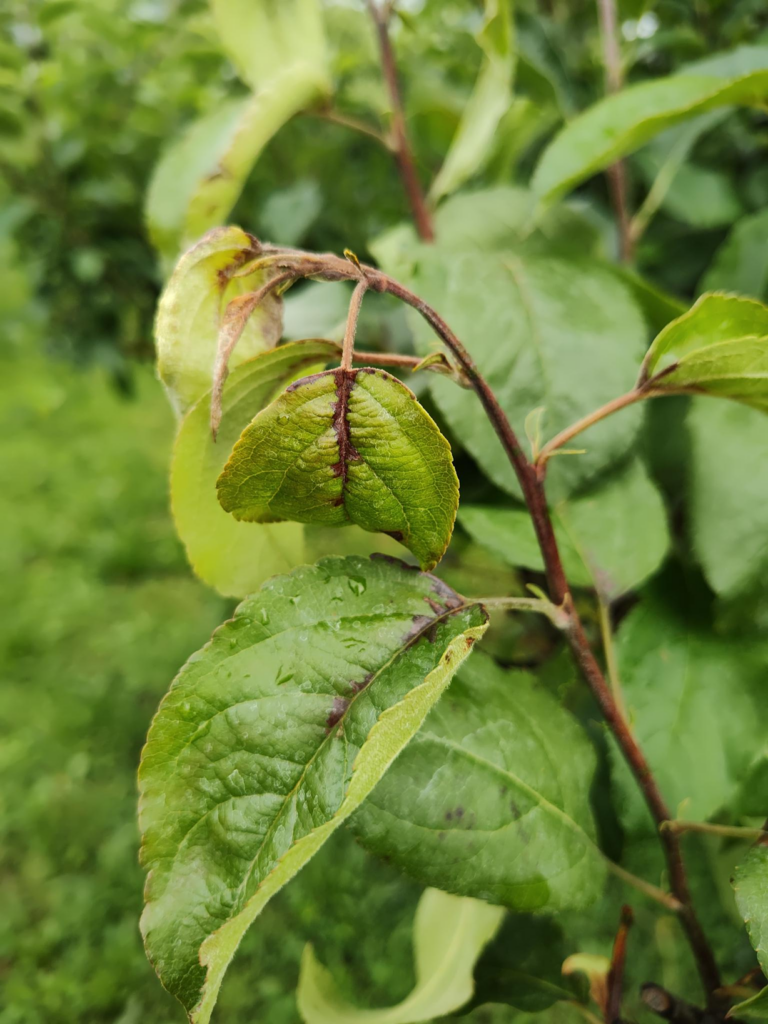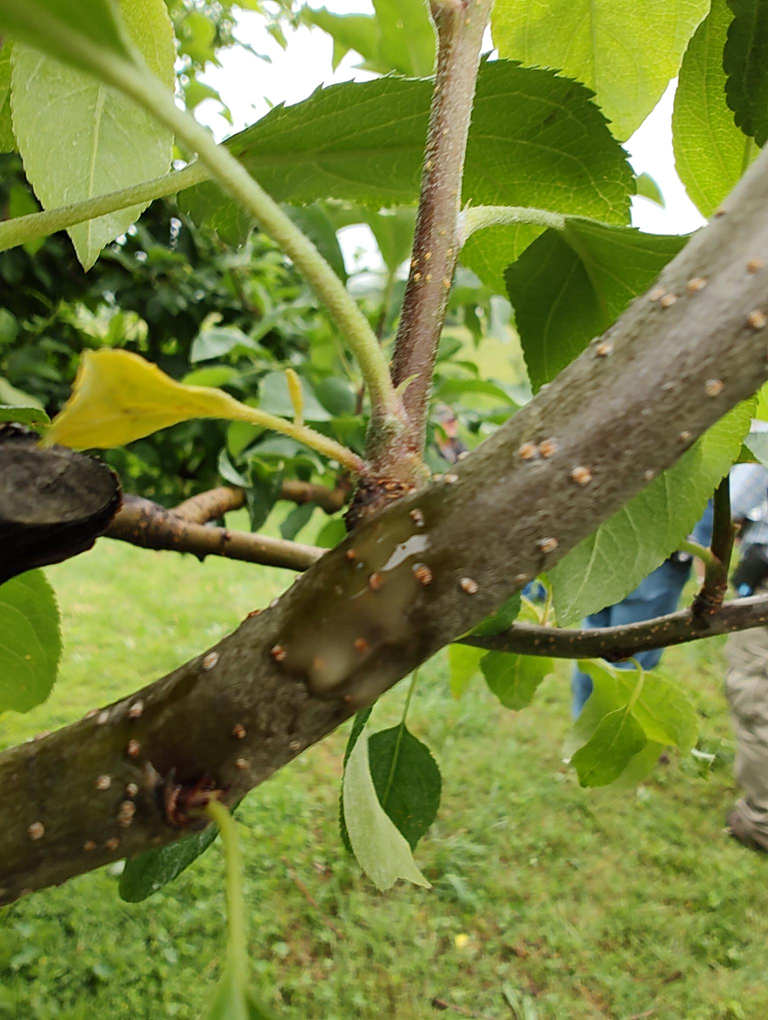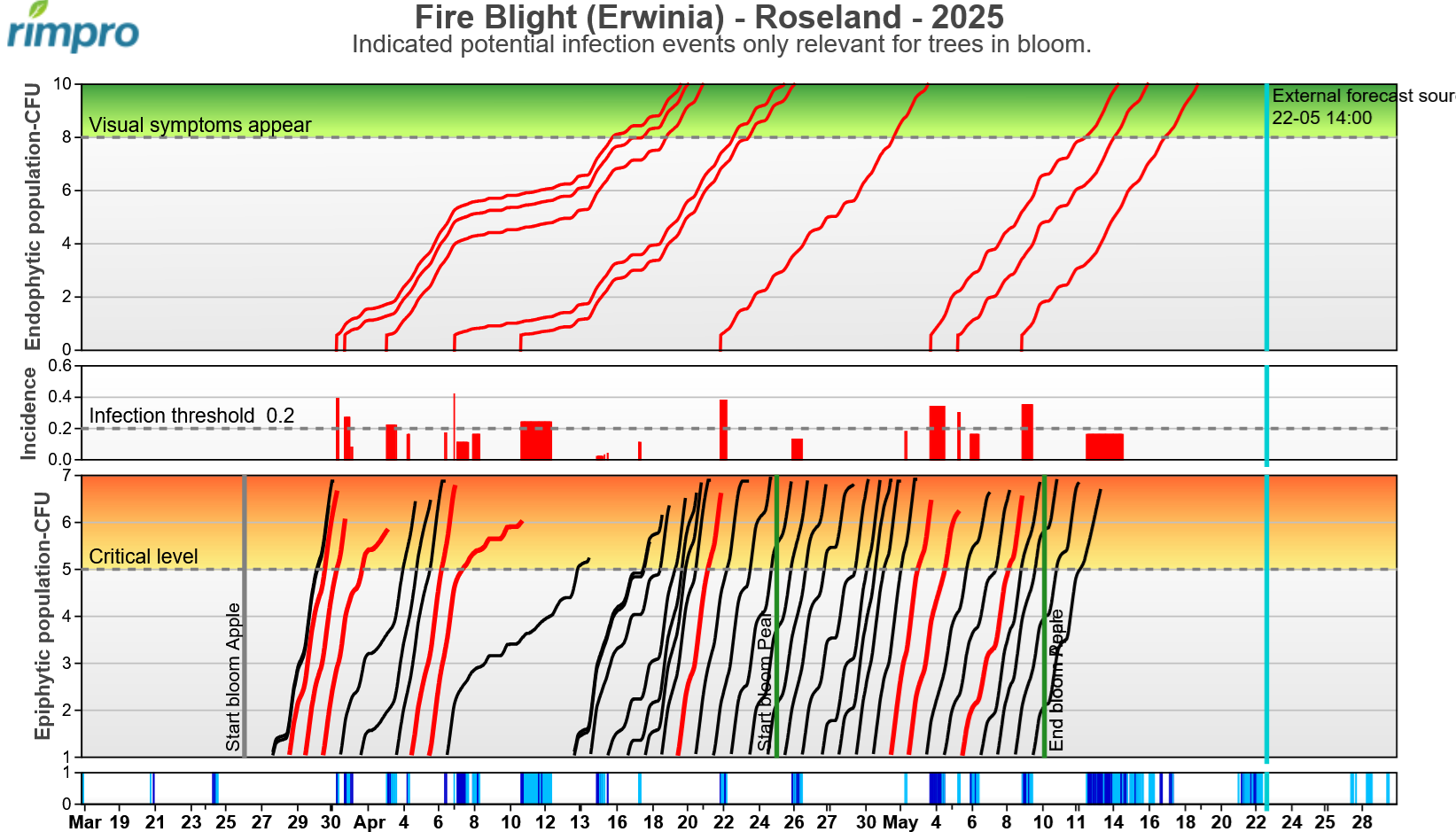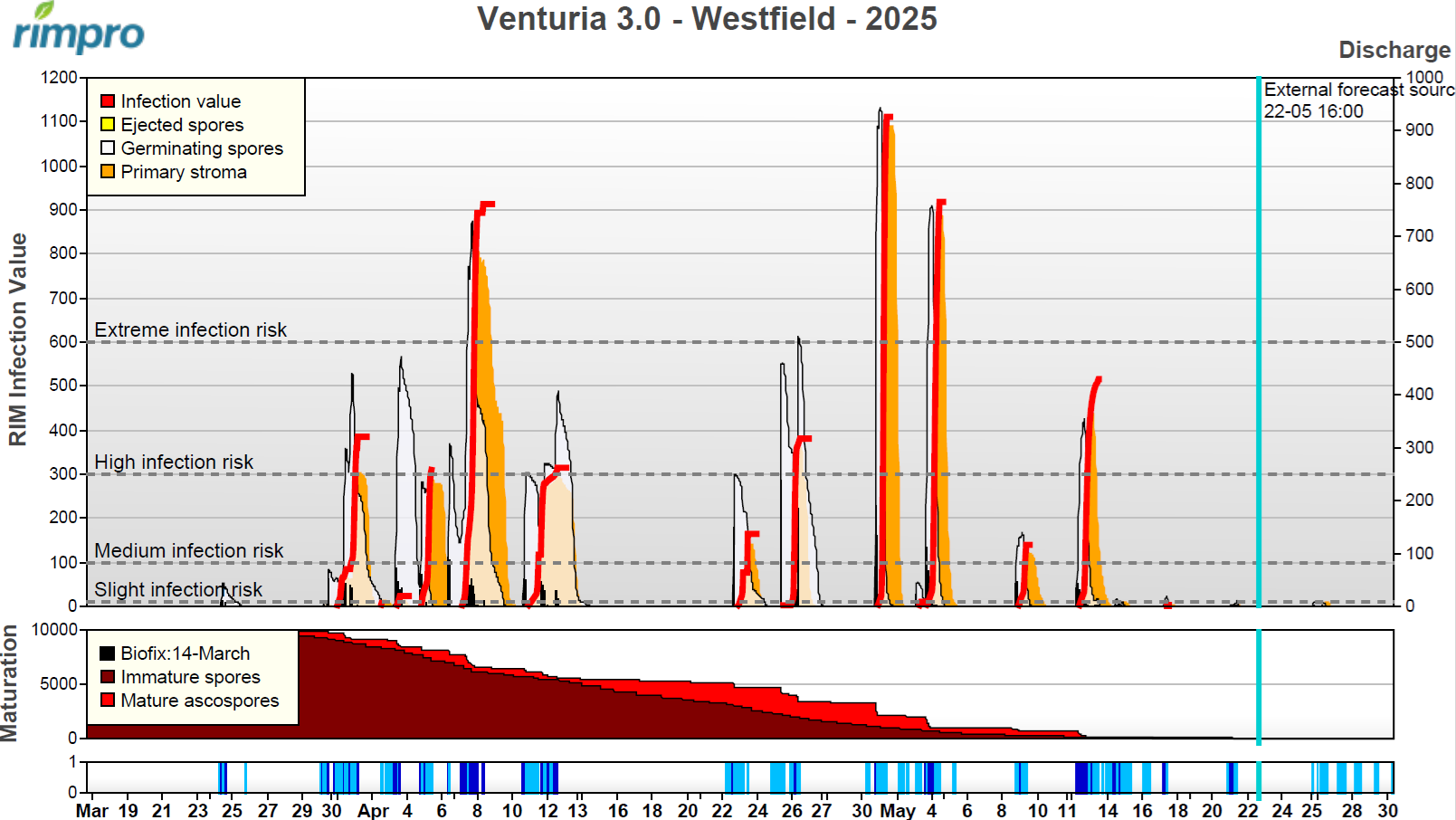(I) Fire Blight Visible From 5 to 12 May in Southern and Central VA; (II) Phytophthora Root and Crown Rot a High Risk with Excessive Rains; (III) Primary Scab Season Over, But Keep Up the Fungicide Applications for 2 Weeks More
(I). FIRE BLIGHT. As of last week (12 May), first fire blight symptoms were visible in Southern and central Virginia (Figs 1 and 2). We are aware that symptoms of fire blight were probably visible much earlier in different warmer locations (from 5 May on), probably stemming from the first infections occurring in April 2025. Based on the time when these symptoms were first seen and looking at the RIMpro Erwinia fire blight incubation model, we can estimate that these symptoms are the result of natural fire blight infections that occurred with warm wetting events between 5 and 15 April (Fig. 3). We we were at early to 80% apple bloom in that period in Winchester area on apple cultivar ‘Fuji’. If in your orchard you see more than 3% blossom blight symptoms, then you likely have active infections taking place on growing apple shoots. If you see uniform dispersed fire blight strikes across your orchard assume that the fire blight bacterium will be present for a long time and you will be at a high risk from when the first flower open until terminal bud set on shoots in the coming years. You will require protection of flowers each spring when models like Maryblyt or EIP in NEWA predict infections risks. If you see fire blight symptoms now, do not apply streptomycin, as the bacterium is already deep inside the green tissues, so it cannot be reached by the antibiotic, and there is a significant risk that you will promote streptomycin resistance development in the fire blight bacterium Erwinia amylovora. Due to this risk of resistance, we never recommend using streptomycin when symptoms are visible. The only exception is a hail event when you can use this antibiotic within 24 h after hail to prevent trauma blight. Applications of streptomycin when symptoms of fire blight are visible, and there is no hail as justification to use it, lead to resistance which in turn leads to reduced antibiotic efficacy or even worse, complete loss of its efficacy.



Spray options for fire blight now. At this moment, if symptoms are visible, apply plant growth regulator (PGR) prohexadione-calcium, in the formulation called Kudos 27.5 WDG, and add one pound of spray grade ammonium sulfate (AMS) to it for every pound of Kudos 27.5 WDG. This material will harden off your shoots and thus reduce susceptibility of not-yet-infected shoots. Apogee is no longer be available on market, so Kudos is the only option. This material will also slow down the invasion shoots by the fire blight bacterium. This PGR works by inhibiting hormones of growth in the green tissues and thus reduces the vegetative tree growth i.e. shortens the shoot length.
More importantly, prohexadione-calcium shortens the period of terminal shoot growth and bridges the time to terminal bud set. Because the trees are no longer susceptible to fire blight infections when shoots stop its growth, i.e. when terminal buds set on shoots, application of Kudos will speed the onset of terminal bud formation, thus reducing the period of shoot susceptibility to infection and reducing the chance for spread of fire blight on other shoots. If symptoms are numerous, mature bearing orchards should be sprayed with 12 oz of Kudos per 100 gal, preferably in a dilute spray, to get a good coverage of all shoots. This will help reduce the number of fire blight cankers developing on wood by disease invasion from infected flowers and shoots. Management should also include applying a labeled copper material for fire blight during shoot growth (e.g. Badge X2 and Badge SC) at no more than 0.2 lb/A of metallic copper equivalent (~ 3 oz of metellic copper equivelant per acre). Use copper by avoiding slow drying conditions before or after its use as it can cause fruit russetting. This is not a concern in cider apple orchards. Even a low rate like this can cause fruit russetting at slow drying conditions, especially if residue from multiple previous applications add up together at a significant rain event. After the copper spray and REI expiration, on a cool dry day you can move into the orchard and prune fire blight symptoms off to reduce inoculum spread. Copper will only kill fire blight bacteria present on the plant surface, not inside the tissue. As per Dr. Yoder, keep in mind that copper can also cause purple spots on leaves, and this is aggravated with successive applications, so the older leaves may show more injury having received more
applications than younger leaves.
Due to recommended low copper doses and the fact that copper does not kill bacteria inside the infected tissues, the effect of copper will be to slow down or prevent further spread of pathogen to new, uninfected apple shoots. More spray applications may be needed to achieve a good effect. High rates of copper and copper applied just before wet and slow-drying conditions could injure fruit skin up through at least mid-June. Cultivars differ in their susceptibility to copper related russetting. You will need to take into account how prone is each of your cultivars to russetting by copper, so watch the weather forecast to avoid applying copper before wet and slow drying conditions, and apply low-doses of copper probably multiple times with lower water volume (to promote quick drying after spray). When considering use of copper, a tank mix of Cueva and Double Nickel might be the best choice since there are some indications that this mix may be less prone to cause fruit russetting.
Pruning fire blight out. If possible, remove fire blight symptoms as soon as they appear, after you applied Apogee or Kudos. Cutting out the infected strikes at 18 to 24 inches below the visible margin of infection on dead shoots or flowers aims to remove bacteria that might have penetrated into the symptomless wood far below the infection margin. If these length requirements below symptom edge could not be met, pruning should be done into the closest perennial wood (at least 2-yr-old, and 4-6 inches into this wood if possible). Prune on a cool dry day and never before, during or soon after rain of heavy dew. Dew and rain allow spreading fire blight more. All pruned out brush should be left on the ground, close to the tree, and flail-mowed or removed from the orchard after the branches are completely dry (cuts show no green cambium visible when bark is scraped with a knife). If there is enough space in the mid-rows to leave the brush on the ground, without preventing passage of air-blast sprays with a tractor, copper could also be applied after pruning. During symptom removal, pruning tools should be disinfected at least between each tree with 70% rubbing alcohol or 10% bleach solution. Even though the true benefit of using any specific disinfectant for tools is still debated or questioned, I would recommend using one of these disinfectant solutions. If pruning is done rapidly, as soon as first symptoms occur, continue scouting daily after the first pruning to remove any additional strikes that develop subsequently.
(II). PHYTOPHTHORA ROOT AND CROWN ROT is a significant concern in 2025 due to excessive amounts of rain per each event and very frequent rain events, leading to high water table in the soil, and following the droughts in 2024. Both these factors favor this disease to infect apple roots, crown and collar. Before you decide to apply a material send the sample to the team at Plant Disease Clinic to make sure you have a positive ID on the disease: Virginia Tech’s Plant Disease Clinic. The best recommendations are to use phosphite (Prophyte) plus captan fungicides applied foliarly, prior to the onset of the disease, on a 30-60 day interval. Most susceptible are trees on M.7 and M.26 as this rootstock can be very susceptible to Phytophthora root and crown rot. There aren’t a lot of post infection management practices for this disease as they rarely work once the disease has set in the orchard. This water mold is almost as dangerous as fire blight because once it enters the wood it is protected in the wood from materials we apply. Thus only preventive applications will be the most effective. After the disease is established in a block this year, you can only treat soil near trees in fall this year (Label is the law – read it). Or what you should have done, is applied it in early spring this year, if you had a known history of this disease in the past or you have a bad spot for an orchard, you have not done tiling, and the site is prone to water logging. The early spring or late fall applications using Ridomil Gold EC should be applied so that the material hits the apple wood. Directed trunk spray seem to work better. Keep in mind that even though Ridomil is labeled for bearing trees, the label says “Apply in the early spring before growth begins (established plantings) and in the fall after harvest but before the ground freezes.” In other words, this material must be applied as preventative, early in spring, based on known history of this disease or an orchard location that you think is prone to high water table. On new apple plantings, the first application can only be done 2 weeks after planting. Ridomil Gold SL will not revitalize trees showing moderate to severe disease symptoms.
I will rehash here a very educational e-mail exchange in 2018 that occurred between Drs Wayne Wilcox, David Rosenberger, Kerik Cox and me. The best way to avoid Phytophthora on heavy and wet soils sites is planting on berms and as the older pathologists and crop consultants from Rutgers warn, this is a time-honored technique that too many people have forgotten about. It is a bit of a management pain at times, but so is a dying orchard. Growers who are replanting onto heavy soils would benefit from reshaping the orchard into slight berms along the tree lines before trees are planted. This can be done even with high-density plantings if one attempts to raise the tree line elevation by only 6 or 8 inches compared to the row middles. Just a bit of elevation can improve tree performance and reduce/eliminate risks of Phytophthora collar rot. If growers report that berming will make the drive rows too wet to get through with a sprayer, then you know that the site should not have been planted before drainage tile is installed (second best method for cultural control of Phytophthora root rot). Phytophthora water mold pathogenic species require water for their spores to swim in to reach the root or be rain-splashed onto the collar to infect them. Several soilborne Phytophthora species that have been studied in detail release only about 10% as many infective zoospores from their sporangia at an elevation of 4 inches above a standing water table/puddle as they do in the saturated soil below, with virtually no zoospore release occurring 10 inches above the water table. The effect of planting susceptible cultivars on beds raised to a height of approximate 12 inches versus those planted on the flat ground was no Phytophthora infections. As Wayne Wilcox summarized it, when Phytophthora species cause only root rot, treatment with Ridomil etc. provides at least a theoretical opportunity to stop the disease progress and for the plant to regenerate new (protected) roots and largely recover. He said that he has seen this several times with raspberries and it’s also a common scenario with PRR (not PCRR) on avocado, sometimes citrus and walnut also. In contrast, once a tree is girdled beyond a certain point of no return, it’s going to stay that way (i.e., it won’t regenerate a new crown) and at best will just limp along. Unfortunately, this is the typical scenario that we see on Rosaceous fruit trees such as apple and stone fruits.
(III) APPLE SCAB. We had 6 to 10 major apple scab infection periods across Virginia in 2025 with this number varying depending on a location (Figures 4, 5). Based on RIMpro Venturia 3.0 model predictions, primary apple scab season has ended on 10 May 2025 (ascospore number in the spore bank in the leaf litter on the orchard floor fell below 5%). Regardless of the primary scab season end date we report here, the fungicide spray coverage needs to be continued on a tight spray interval up to 2 weeks after the date of primary scab season end date. This is absolutely necessary because you do not know how good your coverage was in the major spring scab infection events and juniper rust infections warrant continued applications ahead. So, if any scab lesions arise now from coverage issues associated with a lot of rains depleting the fungicide residue fast or due to missed fungicide applications before any rains during early spring, it will be much harder to have scab-free crop until harvest. Risks from scab infections are now high in orchards where current year scab lesions are visible on leaves or on fruit. This is because asexual spores of apple scab fungus, called conidia, are available for infection from these lesions. In those orchards protection from scab continues with higher rates of captan as the secondary infections by asexual spores called conidia, which is what is inside of the velvety scab lesions you see, are now able to infect. Leaves are still expanding now on terminal shoots and can be infected with scab. However, at the same time, these leaves can hold much more fungicide residue to protect from diseases, allowing some redistribution during low-amount rains.


